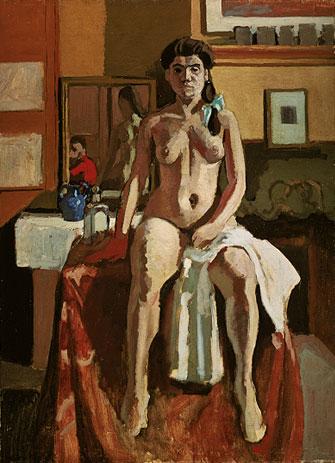Henri Matisse Gallery
Oil on canvas
32 x 23 1/4 in. (81.3 x 59.0 cm)
Tompkins Collection, 1932 Res. 32.14
“What interests me most,” Matisse wrote, “is neither still life nor landscape but the human figure. It is through it that I best succeed in expressing the nearly religious feeling that I have towards life.” Here, in a rigorously balanced composition, the curves of the model’s body are accentuated by the interlocking rectangles of the background, where the artist and his model are reflected in a mirror. Matisse declared that “the whole arrangement of my pictures is expressive. The place occupied by figures or objects, the empty spaces around them, the proportions, everything plays a part.” In this early work, Matisse is already a master of color, playing off vibrating reds and blues against the blocks of warm earth tones representing furniture, walls, picture frames, and blank canvases.

viewer |
|
|
| Bathers by a River |
| Italian Woman |
| Dance |
| Promenade among the Olives |
| Butterfly Net |
Carmelina |
| Abduction of Europa |
| Seance du Matin |
Biography
Bulletin Board
Renowned Art
(home)
Matisse was the leader of the Fauvist (meaning Wild Beasts) Movement, a painting style which focused on pure colors used in an aggressive and direct manner. His style changed many times over the years, but he never gave up his art. Matisse continued creating even into his 80's, when cancer had taken over his body. This was the time when he created the papercuttings that he is perhaps best known for. Matisse understood perfectly the relationship between color and shape, a talent which rightfully earned him the name "Master of Color."
all artists, with thumbnails: by birth year | alphabetically
all artists: by birth year | alphabetically
artists born in the 13th 14th 15th 16th 17th 18th 19th 20th century